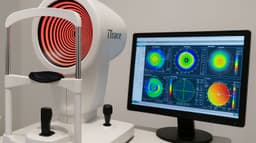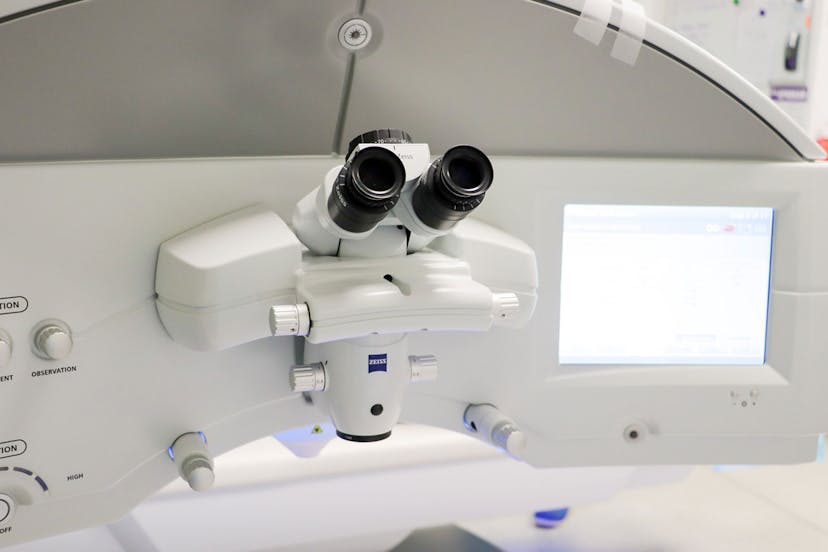
A Deep Dive Into The PRK Laser Eye Surgery Process
Photorefractive Keratectomy (PRK) stands as a pivotal milestone in the evolution of laser eye surgery, revolutionising the landscape of vision correction. The roots of PRK trace back to the 1980s, marking the initial efforts to utilise excimer lasers for reshaping the cornea and addressing refractive errors. Dr. Theo Seiler and Dr. Marguerite McDonald played instrumental roles in advancing the concept of PRK, with early experiments conducted on animal models. However, it was not until the 1990s that PRK gained widespread recognition and acceptance as a viable surgical option for vision correction.
The Medicines and Healthcare Products Regulatory Agency (MHRA) in the UK is responsible for regulating medical devices, including those used in laser eye surgery. While the specific approval dates may vary, PRK and other laser refractive surgeries became increasingly available in the UK during the 1990s as the technology and procedures matured. By the late 1990s and early 2000s, PRK had become an established and widely accepted method for vision correction, offering an alternative to traditional glasses and contact lenses.
Unlike its predecessor, radial keratotomy, which involved making incisions on the cornea's surface, PRK worked by directly sculpting the corneal tissue using the excimer laser. This advancement addressed several limitations of earlier procedures and offered improved predictability and safety. Over the years, technological refinements and enhanced surgical techniques have elevated PRK's efficacy, making it a trusted choice for individuals seeking freedom from glasses or contact lenses. Today, PRK stands as a testament to the ongoing progress in ophthalmology, providing a reliable and transformative solution for those seeking clearer, unaided vision.

What Is The Technology Behind PRK?
PRK is a laser eye surgery that uses advanced technology to reshape the cornea, the clear front part of the eye, to correct refractive errors such as nearsightedness (myopia), farsightedness (hyperopia), and astigmatism. The primary technology employed in PRK is the excimer laser.
Here's an overview of the key steps and the technology behind PRK:
Preoperative Evaluation
Before the surgery, the patient undergoes a thorough eye examination, including corneal mapping and measurement of the refractive error. This data helps the surgeon create a precise treatment plan.
Surface Ablation
Unlike LASIK (Laser-Assisted In Situ Keratomileusis), another common laser eye surgery, PRK does not involve creating a corneal flap. Instead, the surgeon gently removes the thin outer layer of the cornea called the epithelium. This exposes the underlying corneal tissue for laser treatment.
Excimer Laser Technology
The excimer laser used in PRK emits a cool ultraviolet beam of light. Unlike traditional lasers, the excimer laser doesn't generate heat, minimising the risk of thermal damage to surrounding tissue. The precision of this laser is crucial in sculpting the cornea with accuracy measured in micrometers.
Corneal Reshaping
The excimer laser precisely removes microscopic amounts of corneal tissue based on the patient's refractive error. For nearsightedness, the laser flattens the cornea, while for farsightedness, it steepens the cornea. To correct astigmatism, the laser smoothens irregularities in the cornea.
Postoperative Care
After the laser treatment, the cornea is left to heal. The epithelium regenerates naturally over a few days. During this healing period, patients may experience some discomfort, and they are prescribed medications to manage pain and prevent infection.
The key technological aspect of PRK lies in the precision and safety of the excimer laser, which allows for highly controlled corneal reshaping. The surgery aims to improve the way light enters the eye, ensuring it focuses correctly on the retina for clearer vision without the need for glasses or contact lenses.

PRK vs Lasik
Photorefractive Keratectomy (PRK) and Laser-Assisted In Situ Keratomileusis (LASIK) are both popular laser eye surgeries designed to correct refractive errors and reduce dependence on glasses or contact lenses. While they share a common goal, there are key differences in the procedures:
Corneal Preparation
- PRK: The surgeon removes the thin outer layer of the cornea (epithelium) before applying the excimer laser to reshape the cornea.
- LASIK: A flap is created on the cornea using a femtosecond laser. The flap is lifted to expose the underlying cornea for laser treatment.
Corneal Reshaping
- PRK: The excimer laser sculpts the corneal tissue directly after the epithelium is removed.
- LASIK: The excimer laser reshapes the cornea after the flap is lifted.
Recovery Time
- PRK: Typically, the recovery process is longer as the epithelium needs time to regenerate. It may take several days to a week for vision to stabilise.
- LASIK: Recovery is often quicker since the corneal flap serves as a natural bandage, and most patients experience improved vision within a day.
Discomfort and Pain
- PRK: Patients may experience more discomfort and pain during the initial healing period due to the removal of the epithelium.
- LASIK: Discomfort is generally less, and the healing process is often more comfortable for patients.
Suitability
- PRK: Suitable for individuals with thinner corneas, irregular corneal anatomy, or those at a higher risk of corneal flap complications. It may be recommended for people with certain occupations or lifestyles that increase the risk of flap dislocation.
- LASIK: Generally suitable for a wider range of patients, but there are some restrictions based on corneal thickness and other factors.
Long-Term Results
- PRK and LASIK: Both procedures have been shown to provide long-term, stable results in terms of vision correction.
The choice between PRK and LASIK depends on individual factors, such as corneal thickness, lifestyle, and personal preferences. While LASIK is more commonly performed, PRK may be preferred in specific cases where the cornea is not suitable for flap creation or if a longer recovery time is acceptable. Both procedures have high success rates in improving vision and patient satisfaction. Consulting with an eye care professional is crucial to determine the most suitable option based on individual circumstances.
How Much Does PRK Laser Eye Surgery Cost?
The cost of PRK in the United Kingdom can vary based on several factors, including the clinic or surgical center, the surgeon's experience, the technology used, and the specific pre-and post-operative care provided.
It's recommended to contact reputable eye care clinics or laser surgery centres in the UK for accurate and current pricing information. During your inquiry, consider asking about what is included in the overall cost, such as pre-operative evaluations, the surgery itself, post-operative care, and any potential enhancements or follow-up visits.
Additionally, it's essential to ensure that the clinic and surgeon you choose are reputable, experienced, and adhere to the necessary safety and quality standards. Some clinics may offer financing options to help manage the cost, so it's worth discussing payment plans if needed.
How Many Years Does PRK Last?
The long-term stability and effectiveness of PRK laser eye surgery can vary among individuals, and factors such as age, pre-existing eye conditions, and changes in prescription over time can influence the duration of the results. In general, PRK is considered a permanent procedure, and many individuals experience a lasting improvement in their vision.
Research and clinical studies have shown that the majority of patients maintain stable and satisfactory vision after PRK. However, it's essential to note that, like any medical procedure, there can be exceptions, and individual results may vary. Some people may experience changes in vision over the years, particularly as they age and presbyopia (difficulty focusing on close objects) becomes a factor.
Regular eye examinations and follow-up appointments with an eye care professional are crucial to monitor any changes in vision and address them appropriately. In some cases, enhancements or additional procedures may be recommended to maintain optimal vision.
It's important to discuss the expected outcomes and potential long-term considerations with your eye surgeon during the pre-operative consultations. They can provide personalised information based on your eye health and specific circumstances.

Can You Get 20/20 Vision With PRK?
Yes, many individuals achieve 20/20 vision or better after undergoing Photorefractive Keratectomy.
The goal of PRK, like other laser vision correction procedures such as LASIK, is to reduce or eliminate the need for glasses or contact lenses by improving the way light focuses on the retina. The success of achieving 20/20 vision depends on various factors, including the initial prescription, the health of the cornea, and the individual's healing response.
While many people achieve excellent visual outcomes with PRK, it's important to note that results can vary among individuals. Some may achieve 20/20 vision shortly after the procedure, while others may take a bit longer for their vision to stabilise. Additionally, some individuals may experience minor imperfections or variations in vision, which can be addressed through enhancements or fine-tuning procedures if necessary.
Regular follow-up appointments with the eye surgeon are essential to monitor the healing process and address any concerns. My-iClinic can provide specific information about the expected outcomes based on your individual circumstances during the pre-operative evaluation.
Is There a Good Age To Get PRK?
The suitability of PRK (Photorefractive Keratectomy) is not solely determined by age, but rather by the stability of the individual's prescription and overall eye health. However, there are certain considerations related to age that may influence the decision to undergo PRK:
- The prescription for glasses or contact lenses should be stable for a specific period before considering PRK. This stability is important because vision changes can occur during adolescence and early adulthood. Therefore, most eye surgeons prefer to perform PRK on individuals whose prescriptions have remained relatively constant for at least one to two years.
- PRK is typically recommended for individuals who have reached adulthood, as the eyes tend to stabilise in terms of prescription changes by this stage. While there is no strict age limit, most people undergoing PRK are in their late teens or older.
- Individuals typically need to be at least 18 years old to consent to such procedures.
- PRK corrects distance vision but does not address presbyopia, a natural age-related difficulty in focusing on close objects. People over the age of 40 may still need reading glasses after PRK to manage presbyopia.
It's crucial for individuals considering PRK to undergo a thorough pre-operative evaluation with an eye care professional to assess their candidacy. The evaluation will include an examination of the overall health of the eyes, corneal thickness, and stability of the prescription. The decision to undergo PRK should be based on individual circumstances and the guidance of a qualified eye surgeon.
Ultimately, the best age for PRK is when the eyes have stabilised, and the procedure is deemed safe and appropriate for the individual's eye health and lifestyle.
Unlock Your Future With My-iClinic
Are you tired of reaching for your glasses or fumbling with contact lenses every morning? My-iClinic invites you to experience the next level of vision correction through our state-of-the-art Photorefractive Keratectomy (PRK) technology!
Why Choose My-iClinic?
With a commitment to precision and patient satisfaction, My-iClinic harnesses the power of the latest excimer laser technology for PRK procedures. Our highly skilled and experienced surgeons utilise advanced techniques to reshape the cornea, bringing you closer to achieving 20/20 vision or better.
Quick, Safe, and Effective
Experience the freedom of clear vision sooner than you think! PRK at My-iClinic offers a swift and safe solution for vision correction, with many patients enjoying improved eyesight shortly after the procedure.
Personalised Care
At My-iClinic, we understand that every eye is unique. Our personalised approach ensures that your PRK treatment is tailored to your individual needs, providing the best possible outcome for your vision.
Book Your Consultation Today
Ready to embrace a life without the hassle of glasses or contacts? Take the first step towards visual freedom by scheduling a comprehensive consultation with our expert team. Discover how My-iClinic's cutting-edge PRK technology can transform your vision and enhance your lifestyle.
Find out more by Speaking to our team









